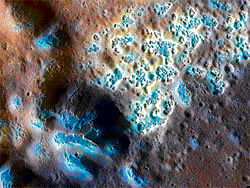Close-ups reveal a weirder Mercury

The findings published in Science include a previously unknown type of landform and evidence of volatile elements that most researchers assumed had been baked out of Mercury long ago, as well as five other reports describing the planet’s landscape, surface chemistry and magnetic field.
For MESSENGER researcher and planetary geologist David Blewett of the Johns Hopkins University Applied Physics Laboratory in Laurel, Maryland, the message is clear: “Mercury is weird; everything about it is weird. We don’t know what kind of rocks it’s made of, we don’t know its colour and it’s not depleted of volatiles like everyone thought.”
It was Blewett and his team who, examining the craft’s highest-resolution images to date, discovered depressions scattered along the floors, walls and central peaks of craters in Mercury’s northern hemisphere.
These irregularly shaped hollows, which are unlike any landforms previously known to researchers, range from tens of meters to a few kilometers across and look fresh enough not to have been altered by meteorite impacts during the long history of the planet.The hollows do not seem to have resulted from volcanic eruptions, says Blewett. However, they do look a little like the ‘Swiss cheese’ terrain seen at the south polar region of Mars.
There, solar heating causes deposits of carbon dioxide ice to sublimate carrying bits of adjoining material away from the surface in the process. By analogy, Blewett and his team propose that temperatures beneath Mercury’s surface should be cool enough for some volatiles to remain stable. But debris striking the planet would deliver enough energy to trigger their release, hollowing out the surrounding terrain in the process, says Blewett.
“The hollows are indeed a puzzle, and I think that the leading explanation is sublimation,” says David Rothery, a planetary scientist at the Open University in Milton Keynes, U K, who was not involved in the study. Most models that seek to explain Mercury’s immense iron core – require that the planet was exposed early on to searing heat.
The latest observations from MESSENGER suggest that this scenario is not correct. X-ray spectrometer results from the craft suggest that sulphur is at least ten times more abundant on Mercury’s surface than it is in the earth’s mantle.
Deccan Herald is on WhatsApp Channels| Join now for Breaking News & Editor's Picks